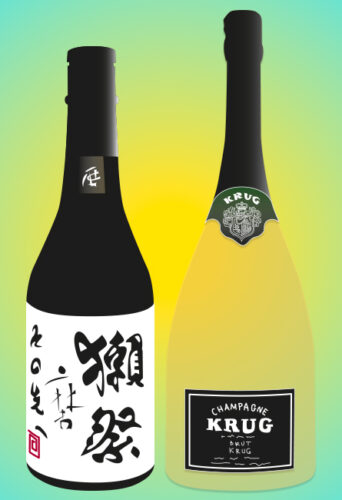Event — Rares Sakes & iconic Champagnes
- masterclass
- DECEMBER 13, 2016
- ESPACE FERT, RUE BARTON, 7 — 1201 GENEVA
- CHF 200
For this Part II dedicated to Saké, Baghera Wines is thrilled to invite you to this “Rare sakés & iconic Champagnes” tasting under the aegis of Gautier Roussille, a French saké expert. Gautier will share his extensive knowledge of this rare eastern wine also called nihonshu that we will be tasting alongside some high-pitched Champagnes – another field where Gautier has proved great skills and knowledge.
- Dassai Beyond * Salon 1988
- Fukugen Junmai * Vouette et Sorbée Fidèle
- Raifuku JG chokarakuchi * Francis Boulard Les Rachais Extra-Brut 2008
- Nabeshima JDG * Agrapart Mineral 2010
- Kikumasamune taruzake JG * R. Bereche Le Cran 2008
- Sohomare Kimoto JDG (mag) * Krug Grande cuvée
- Hyakujuro Jukusei Koshu * Charles Heidsieck réserve privée (mise en cave 1998)
Wine and sake are two drinks deeply rooted in the traditions of their country of origin. They have evolved for centuries in parallel with the cultures which gave birth to them, to the point of becoming inseparable from them in the collective imagination.
Today, like Western culture, wine has become internationalized while, as a result of an island culture, sake has remained almost completely confined to Japan (and to the Japanese diaspora). From this isolation, it has retained a certain original purity, without ignoring the progress of the world around it. As in the rest of Japan, sake has evolved while retaining the strength of its traditions.
Confronting wine and sake therefore becomes a comparative study of Western and Japanese cultures. Many common traits appear while the constraints of the environment and certain radically different philosophical conceptions give rise to two unique drinks.
The first divergence arises from the raw material: the grape contains sugar and many aromatic precursors. Its fermentation is therefore easy and naturally produces wine. Rice, on the other hand, is an inert and almost neutral raw material that man must, by his art, transform into an alcoholic and aromatic drink.
Thus, wine, like a gift from the gods, is born in the vineyard, while sake from the art of men is given as an offering to the gods (the kamis of the Shinto religion).
We will see during two tastings what are the common points and the differences between wine and sake by tasting side by side and comparing these two great cultural drinks. We will deal with grape varieties, terroir, methods and techniques, the conception of taste, quality and the idea of ideal which results from this, the link between these drinks and the cuisine of their respective countries ... we will explore all which makes wine and sake two magnificent cultural drinks, in what brings them together as much as in what opposes them.
Gautier Roussille
A cultural beverage par excellence, its origin merges with that of the Japanese people and their religion: Shinto. Over the centuries, methods of obtaining sake have evolved into one of the most complex forms of beverage in the world.
The first step in obtaining sake is polishing the rice, which involves removing the outer part of the grain, this part being variable. Sakes produced from rice from which more than 40% of the mass was removed during polishing are called “ginjo”. The most prestigious sakes generally fall into this category.
After standing for a while, the rice is soaked for a few minutes and then steamed. After cooling, part of the rice, the “kojimai”, is inoculated with a mushroom, the “koji”. The development of the koji lasts about three days during which the rice is regularly stirred to ensure a homogeneous development of the fungus. The rice on which the koji was developed is called "kome-koji" (kome = rice). It allows the transformation of rice starch into sugar, a step necessary for fermentation.
A mixture of kome-koji, cooked rice and water is then made. This mixture, called “shubo”, is then sown in yeast using various techniques. The yeasts develop for one to two weeks before the population reaches its maximum. Then added to the shubo, three times in four days, is a new mixture of kome-koji, cooked rice and water.
There follows a more or less long period of fermentation at low temperature (from 2 weeks to 1 month, between 6°C and 20°C) which ends during pressing. The raw sake thus obtained will generally be filtered and pasteurized before marketing.
Thanks to this long and exhausting process, rice is transformed into a pure and delicate, aromatic and complex drink, nihonshu.
Gautier Roussille
Let's go further...

